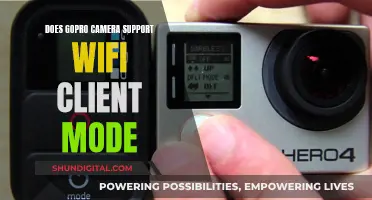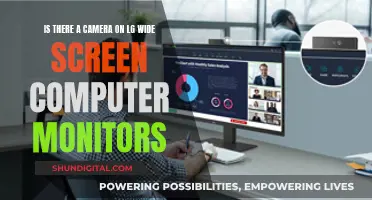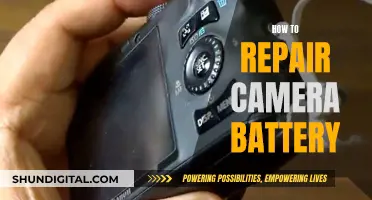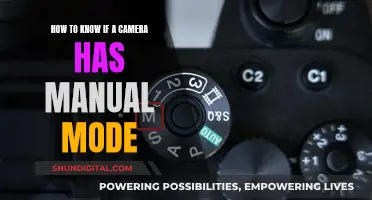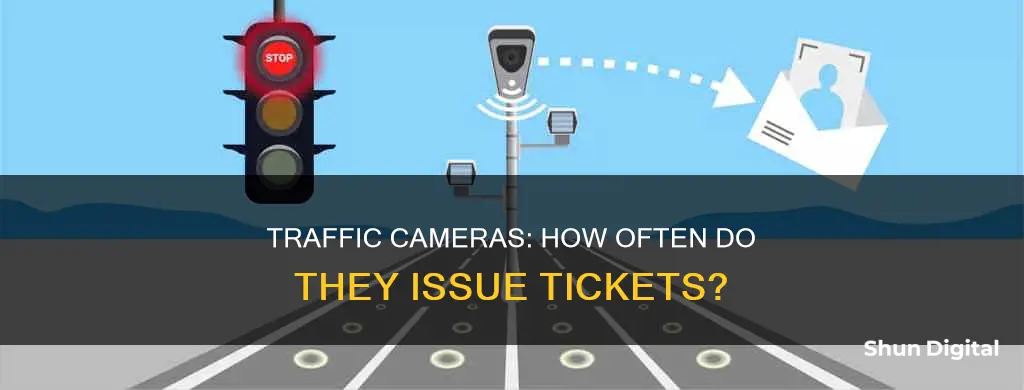
Traffic cameras are an increasingly common feature of roads in the US and worldwide. They are used to monitor traffic patterns and enforce road safety, but they are also a source of controversy. There are several types of traffic cameras, including red light cameras, speed cameras, and stop sign cameras, each with its own purpose and method of operation. These cameras are often triggered by sensors installed in the road and can result in tickets being issued to drivers. The use of traffic cameras has been shown to reduce crashes and save lives, but some people argue that they are a violation of privacy and due process. The legality of traffic cameras has been upheld in multiple court rulings, and they continue to be implemented in more locations.
| Characteristics | Values |
|---|---|
| Purpose | To monitor traffic patterns, detect violations, and improve road safety |
| Types | Red light cameras, speed cameras, stop sign cameras, school bus cameras, traffic surveillance cameras |
| Number of Types | 6 |
| Locations | Intersections, traffic lights, highways, roads, street lights, school zones, work zones, etc. |
| Appearance | Small, cylindrical or dome-shaped; bulky with separate flashes; black protective box |
| Warning Signs | May be posted ahead of camera locations |
| Activation | Motion, passing stop bar, speeding, etc. |
| Data Recorded | Images, videos, date, time, speed, location, etc. |
| Fines | Vary by jurisdiction, typically $50-$100 |
| Revenue | Can generate significant revenue for local governments and private companies |
| Privacy Concerns | Some people consider them a violation of privacy |
| Legality | Ruled legal and constitutional by multiple U.S. courts |
What You'll Learn

Red light cameras detect when a motorist enters an intersection on a red light
Red light cameras are automated ticket-issuing systems placed at busy intersections. They are designed to detect when a motorist enters an intersection on a red light. They are synchronised with traffic signals and work in conjunction with sensors installed in the road. When a vehicle drives into an intersection and passes the stop line, it triggers the camera to take multiple images of the car during the violation.
The cameras are typically bulkier than other traffic cameras, with a large camera box and two external flashes, often mounted separately on poles. There are often multiple cameras at each intersection to capture angles from multiple directions.
The photographs taken by the camera are used as evidence, and a ticket is sent to the motorist via postal mail or email. The ticket includes instructions for paying the associated fine or appearing in court. The fines vary depending on the municipality, with a $50 fine per occurrence in New York, for example.
Red light cameras are not very common due to their high installation costs. They are mostly placed at dangerous intersections with a higher percentage of crashes due to violations.
Mastering Manual Mode in Photography: M Mode Explained
You may want to see also

Speed cameras detect speeding violations
Speed cameras are a type of automated enforcement technology used to detect speeding violations. They are usually placed in less populated areas, such as back roads and residential areas, where speeding is a frequent occurrence. There are two types of speed cameras: fixed and mobile.
Fixed speed cameras are typically mounted on elevated poles at the side of the road and are easily identifiable due to their bulky weatherproof enclosures and external flashes. On the other hand, mobile speed cameras are more challenging to spot as they are not permanently installed. They can be placed on a camera tripod or inside a van, and their locations can vary.
Speed cameras use various technologies to monitor compliance with speed limits, including Doppler radar, LIDAR, stereo vision, and automatic number-plate recognition. These systems can be either camera-based or non-camera-based. Fixed or mobile speed camera systems that calculate a vehicle's average speed over a certain distance are known as average speed cameras.
The use of speed cameras has been shown to effectively reduce crashes and injuries. Studies have found that speed cameras can lead to an 11% to 44% reduction in fatal and serious injury crashes. Additionally, the British Medical Journal reported that speed cameras were effective at reducing accidents and recommended their wider deployment.
While speed cameras are a valuable tool for enhancing road safety, they have also faced some opposition and controversy. Some critics argue that they are used more for revenue generation than for safety purposes. Additionally, there are concerns about the loss of privacy and the potential for governments to establish mass surveillance of vehicle movements. Nevertheless, speed cameras remain a crucial component of road safety strategies, helping to deter speeding and save lives.
Trail Camera Power: Battery or Solar?
You may want to see also

Traffic cameras monitor traffic flow and signal violations
Traffic cameras are an increasingly common feature of roads and highways. While some are used to issue tickets and violations, others are used to monitor traffic flow and conditions. These cameras are typically mounted on poles, bridges, or other structures, and are usually placed at intersections, on-ramps, and other points where traffic is likely to be heavy or congested.
Traffic cameras that monitor traffic flow and signal violations are typically equipped with sensors that can detect the speed of vehicles. This information can be used by authorities to enforce traffic laws and issue tickets to speeding drivers. These cameras can also be equipped with additional features, such as infrared technology, which enables them to capture images at night or in low-light conditions.
The images captured by traffic cameras are transmitted to a control center or network, where they can be viewed in real-time by traffic engineers or law enforcement personnel. These individuals use the images to monitor traffic flow, detect accidents or disruptions, and take appropriate action if necessary. For example, if a traffic camera detects a car pulled over on the side of the road, it can send a live alert to transportation officials, who can then assess the situation and determine the appropriate response.
Traffic cameras play a crucial role in improving road safety and reducing accidents. A study by the Insurance Institute for Highway Safety (IIHS) found that intersections without red light cameras are 30% more likely to have a fatal red-light-running crash rate than those with cameras. By encouraging drivers to follow traffic laws and speed limits, traffic cameras can help reduce the number of accidents and improve the efficiency and safety of the roads.
In addition to their safety benefits, traffic cameras can also aid in city planning and data gathering. The data collected by these cameras can be used by engineers and city planners to create better road plans and develop new traffic management strategies. Overall, traffic cameras are an important tool for monitoring and improving traffic flow and signal violations, enhancing road safety, and making informed decisions about transportation infrastructure.
Kami Wire-Free Camera: How Long Does the Battery Last?
You may want to see also

Dummy cameras are used to deter motorists without issuing tickets
Dummy cameras are used as a deterrent to motorists without issuing tickets. While some argue that they are ineffective and serve no purpose, others believe they are essential in moderating vehicle speeds. Dummy cameras are often placed at busy intersections to capture motorists entering an intersection on a red light. These cameras can be identified by their bulkier size and separate mounting on poles, with external flashes.
The use of dummy cameras is controversial. Some argue that they are a reasonable safety measure, while others view them as an invasion of privacy. The legality of these cameras varies across jurisdictions, with some states banning them, while others adopt a revenue-sharing model where the government and camera operators benefit from the fines.
The effectiveness of dummy cameras in reducing crashes and enhancing safety is questionable, as studies have shown conflicting results. Some believe that dummy cameras cause more rear-end collisions as drivers stop abruptly to avoid tickets, causing tailing motorists to crash into them.
The maintenance and accuracy of dummy cameras are also a concern. Inactive cameras can confuse and distract drivers, potentially leading to accidents. Regular maintenance and testing of these cameras are necessary to ensure their reliability.
Dummy cameras can be identified by their lack of activity. If a camera is not flashing, it may be inactive and non-operational. However, this is not always a reliable indicator, as some active cameras may have a longer duration between flashes.
In conclusion, dummy cameras are a divisive tool used to deter motorists from speeding and running red lights. While some argue that they improve road safety, others believe they are a revenue-generating scheme that invades privacy and may even cause accidents. The effectiveness and legality of dummy cameras continue to be a subject of debate.
GPU Rendering: Camera Mods and Their Impact
You may want to see also

Ticket cameras capture violations and send citations
Ticket cameras, also known as auto-enforcers, are an increasingly common feature of roads in the US and beyond. They are designed to document violations and send citations to the relevant parties. There are several types of ticket cameras, each with a distinct purpose.
Red light cameras are activated when a vehicle passes over the stop bar after the signal has turned red. They typically capture a 12-second digital video of the violation, as well as two images of the license plate. These cameras are usually positioned on the side of the road, facing the intersection, and most states post signs to warn drivers of their presence.
Speed cameras are another type of auto-enforcer, using radar and laser technology to detect when a vehicle exceeds the speed limit, usually by about 10 mph. Once triggered, the camera captures images of the license plate and records a video of the incident, including the date, time, speed, and location. Speed cameras can be found in bulky, brightly coloured boxes or may be more basic, consisting of just a camera on top of a tall pole.
Stop sign cameras are much rarer than red light or speed cameras, with only California and the District of Columbia known to have them. These cameras use radar to detect if a vehicle stops, rolls through, or drives past a stop sign. They are typically found in large boxes and are usually accompanied by a sign warning motorists of their presence.
School bus cameras are installed to catch drivers who illegally pass school buses, thereby endangering children. When the bus stops and deploys its stop signs and flashing lights, the cameras capture photographs of the vehicle and a short video of the violation, which includes a timestamp. These cameras are usually found on the sides of school buses, housed in black protective boxes.
In addition to auto-enforcers, there are also traffic surveillance cameras, which are used to monitor traffic flow and ensure road safety. These cameras are typically much smaller and less conspicuous than auto-enforcers, and they are attached to traffic light poles. They do not generate tickets but instead provide live feeds to help manage traffic and respond to incidents.
Avigilon Cameras: Where Are They Manufactured and Assembled?
You may want to see also
Frequently asked questions
Red light cameras are activated when a vehicle drives into an intersection and passes the stop line. They take multiple images of the car during the violation and the motorist will receive a ticket in the mail.
If you've been caught by a red light camera, you will receive a ticket in the mail or via an app, depending on the state.
If you don't pay the ticket, it may be sent to a collection agency and your credit score may be affected.



